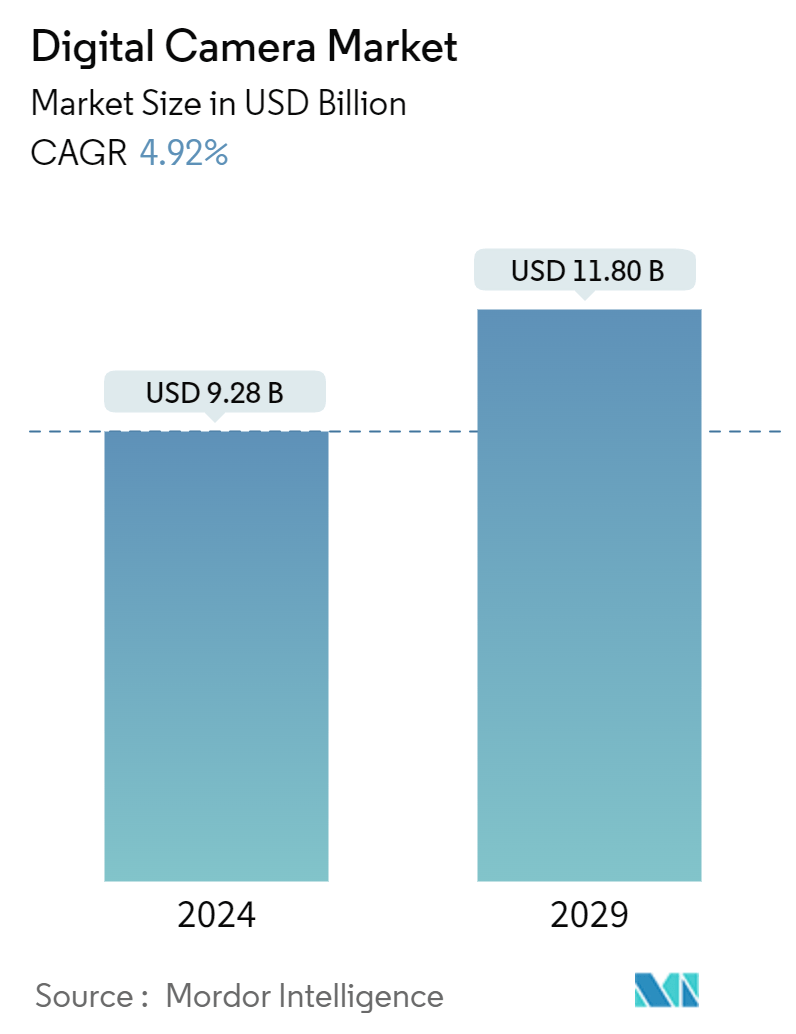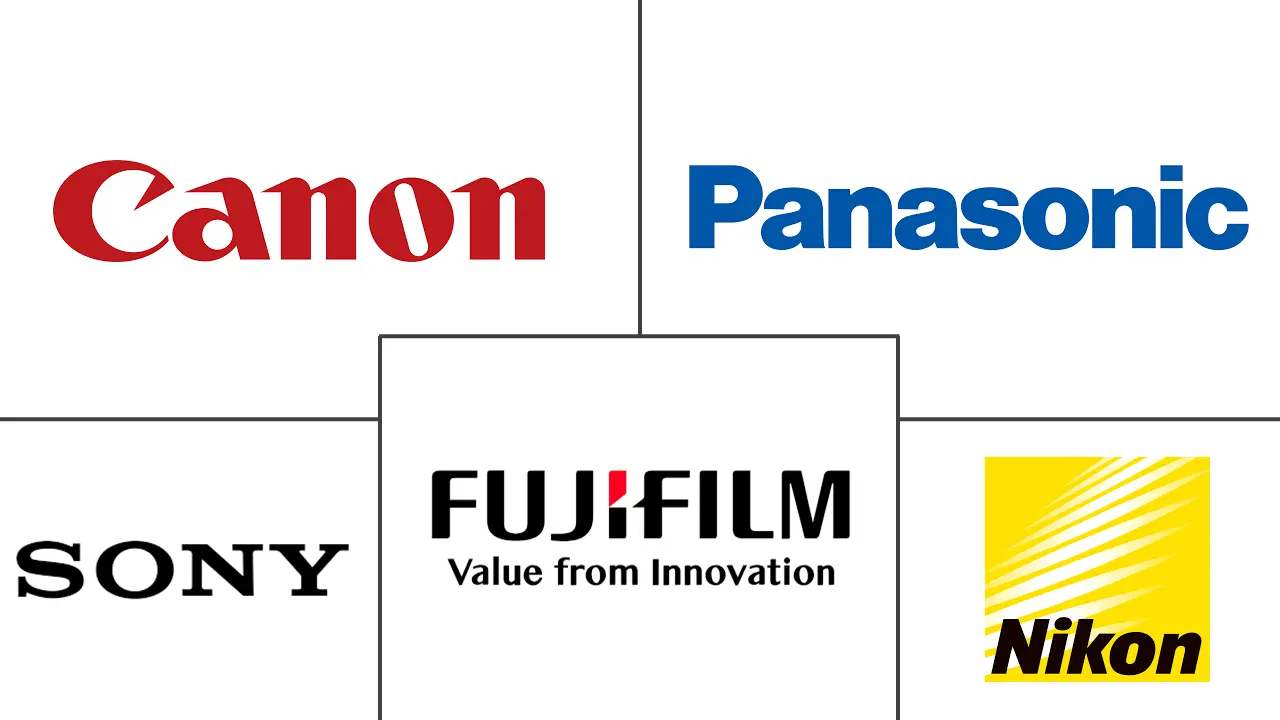Market Size of Digital Camera Industry

| Study Period | 2019 - 2029 |
| Market Size (2024) | USD 9.28 Billion |
| Market Size (2029) | USD 11.80 Billion |
| CAGR (2024 - 2029) | 4.92 % |
| Fastest Growing Market | Asia Pacific |
| Largest Market | Asia Pacific |
| Market Concentration | Low |
Major Players
*Disclaimer: Major Players sorted in no particular order |
Digital Camera Market Analysis
The Digital Camera Market size is estimated at USD 9.28 billion in 2024, and is expected to reach USD 11.80 billion by 2029, at a CAGR of 4.92% during the forecast period (2024-2029).
The rising demand for high-quality photography and videography, particularly among amateur and professional photographers, is a major market driver. Advancements in sensor technology, image processing algorithms, and lens design are enabling cameras to capture stunning images and videos.
Additionally, the incorporation of advanced features, such as AI-driven scene recognition and object tracking, is elevating the user experience. The surging trend of vlogging, coupled with the prominence of social media and content creation, is driving the demand for compact, high-performance digital cameras. With the relentless evolution of technology and shifting consumer preferences, the digital camera market is poised for dynamism, presenting substantial growth prospects.
Artificial Intelligence (AI) Integration in Cameras for Image Processing
- Advancements in artificial intelligence and other recent technologies are driving the growth of the digital camera market. These innovations enable cameras to become smaller and more capable. Artificial intelligence enhances image quality and reduces noise in low-light conditions. The smallest functional camera is now the size of a grain of rice. Modern technology allows security companies to maintain high resolution while minimizing the camera's footprint.
- In response, market players are adopting AI in their offerings. For instance, Canon Inc. is incorporating AI technology. The Canon EOS R3 features an AI-based autofocus system that can track subjects with incredible accuracy. The camera also has an AI-based image processor that can fix most major digital photo issues, such as distortion, vignetting, and chromatic aberration.
- Furthermore, in November 2024, SONY Group CORPORATION launched the Alpha 1 II, the second-generation model of its flagship full-frame mirrorless camera. As the successor to the acclaimed Alpha 1, this new model features numerous upgrades, combining high resolution, speed, and advanced AI-driven autofocus technology designed for both professional photographers and videographers.
- In this way, AI is transforming the photography industry. From improving autofocus systems to enhancing the quality of photographs and automating the editing process, AI is making it easier and more efficient to capture quality images. As AI continues to advance, more innovative developments in the world of photography are expected adding growth to the AI-enabled digital cameras.
Smartphone Photography Challenging Market Growth
- The digital camera market is currently facing significant challenges from competing devices and shifting consumer preferences. Modern smartphones are equipped with advanced cameras that deliver high-quality images wthatmeet or even exceed the needs of average consumers. According to GSMA, the smartphone penetration rate as a share of the population has increased to 69% in 2023 from 68% in 2022, registering significant growth post-pandemic.
- Consequently, many consumers are choosing not to purchase dedicated digital cameras. Smartphones, with their all-in-one convenience, have become the preferred choice. The ability to use smartphones as both cameras and multifunctional tools reduces the perceived value of standalone cameras. This trend is particularly evident since digital cameras often do not provide significant advantages over smartphone cameras in terms of features or usability.
However, as social media content creators continue to proliferate, a key opportunity arises to engage consumers with compact, user-friendly digital cameras that deliver exceptional stills and videos. The market increasingly caters to niche demands, underscoring the growing sophistication and awareness of today's buyers. By keeping pace with consumer trends across various segments and regions, brands and retailers can position themselves against competition from smartphones.
Digital Camera Industry Segmentation
The market is defined by the revenue accrued from the sale of digital camera solutions offered by players operating in the global market.
The digital camera market is segmented by lens type (built-in and interchangeable), camera type (compact digital camera, DSLR (digital single-lens reflex), and mirrorless), end user (pro photographers, prosumers, and hobbyists), and geography (North America, Europe, Asia-Pacific, Latin America, and Middle East and Africa). The report offers the market size and forecasts for all the above segments in value (USD).
| By Lens Type | |
| Built-in | |
| Interchangeable |
| By Camera Type | |
| Compact Digital Camera | |
| DSLR (Digital Single-Lens Reflex) | |
| Mirrorless |
| By End User | |
| Pro Photographers | |
| Prosumers | |
| Hobbyists |
| By Geography*** | |
| North America | |
| Europe | |
| Asia | |
| Australia and New Zealand | |
| Latin America | |
| Middle East and Africa |
Digital Camera Market Size Summary
The digital camera market is experiencing a dynamic phase, characterized by a shift in consumer preferences towards smartphone cameras, which has led to a decline in global digital camera shipments over the past decade. Despite this trend, major manufacturers like Nikon and Canon have carved out a niche by developing full-frame cameras aimed at professional photographers who require high-quality images for their work. The market remains competitive, with key players such as Sony, Fujifilm, and Canon focusing on innovations in mirrorless cameras to capture a larger share of the market. These advancements, coupled with the rise of digital photography and social media platforms, are creating new opportunities for growth. The introduction of feature-rich products and innovative payment methods is expected to bolster the market's expansion during the forecast period.
The Asia-Pacific region is poised to be a significant contributor to the digital camera market, driven by the presence of major companies and a growing interest in photography. The region's increased disposable income and enthusiasm for photography, along with the rising demand for wedding photography, are expected to further stimulate market growth. Despite the challenges posed by the smartphone industry, digital camera manufacturers are focusing on product launches and technological advancements to meet the diverse needs of consumers. The market's recovery post-COVID-19, supported by the lifting of travel bans and the introduction of new products, is anticipated to continue, with mirrorless cameras gaining traction over traditional DSLRs. This trend is expected to drive demand for mirrorless lenses and other related products, as companies invest in developing unique and improved photography solutions.
Digital Camera Market Size - Table of Contents
-
1. MARKET INSIGHTS
-
1.1 Market Overview
-
1.2 Industry Attractiveness - Porter's Five Forces Analysis
-
1.2.1 Bargaining Power of Suppliers
-
1.2.2 Bargaining Power of Buyers
-
1.2.3 Threat of New Entrants
-
1.2.4 Threat of Substitutes
-
1.2.5 Intensity of Competitive Rivalry
-
-
1.3 Industry Value Chain Analysis
-
1.4 Assessment of Macroeconomic Factors on the Market
-
-
2. MARKET SEGMENTATION
-
2.1 By Lens Type
-
2.1.1 Built-in
-
2.1.2 Interchangeable
-
-
2.2 By Camera Type
-
2.2.1 Compact Digital Camera
-
2.2.2 DSLR (Digital Single-Lens Reflex)
-
2.2.3 Mirrorless
-
-
2.3 By End User
-
2.3.1 Pro Photographers
-
2.3.2 Prosumers
-
2.3.3 Hobbyists
-
-
2.4 By Geography***
-
2.4.1 North America
-
2.4.2 Europe
-
2.4.3 Asia
-
2.4.4 Australia and New Zealand
-
2.4.5 Latin America
-
2.4.6 Middle East and Africa
-
-
Digital Camera Market Size FAQs
How big is the Digital Camera Market?
The Digital Camera Market size is expected to reach USD 9.28 billion in 2024 and grow at a CAGR of 4.92% to reach USD 11.80 billion by 2029.
What is the current Digital Camera Market size?
In 2024, the Digital Camera Market size is expected to reach USD 9.28 billion.

